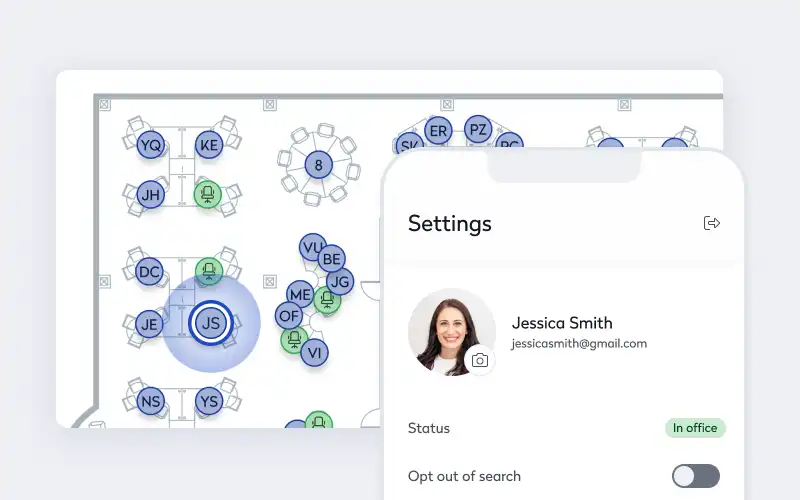
Gone are the days of everyone coming into the office every day of the workweek, and companies must now implement policies and practices that boost employee engagement and satisfaction for onsite and remote workers, plus those working on flexible or hybrid work models. The key is leveraging the right combination of modern workplace tech to create a culture that keeps employees connected to the company and one another.
The value of onsite, remote, and hybrid work model employee engagement
There is an established body of research that shows the importance of ensuring all employees are engaged. In fact, as far back as 2013, the Harvard Business Review was reporting how 71% of respondents rank employee engagement as very important to achieving overall organizational success.
When employees are engaged and satisfied, they are more likely to be productive, creative, and committed to their work, which directly improves overall business performance. High levels of engagement reduce turnover rates, saving costs on recruitment and training while preserving valuable institutional knowledge. Satisfied employees are also more likely to advocate for the company, improving its reputation and potentially attracting new talent.
In the end, investing in employee engagement and satisfaction boosts morale, which then contributes directly to a company’s stability and growth.
Here’s how workplace leaders can keep employees engaged and connected using modern worktech.
Break down communication barriers with collaboration platforms
When team members are working on a project, in-person collaboration makes it easier to share ideas and resolve issues, keeping the project moving forward.
In fact, according to Eptura’s latest Workplace Index report, so many employees list opportunities to collaborate and connect with colleagues as the top two reasons for coming into the office.

But not everyone can be in the office all the time, so companies need to provide the right combination of project management, scheduling, and information sharing platforms.
Instant messaging and chat apps
Support instant messaging and file sharing. They’re the perfect way to keep everyone connected in real or near real time. Teams should be careful about using them as “sources of truth,” though, in case the company decides to move to a different provider.
Video conferencing tools
Popular for video calls, webinars, and large virtual meetings. Screen sharing is a popular feature, where a group of employees can review documents or images together in real time.
Project management software
Helps teams organize, track, and manage their work with tasks, projects, conversations, and dashboards. The better platforms tend to be more customizable, empowering teams to manage workloads, tracks projects, and optimize processes.
Collaborative document and file sharing tools
Provides secure file sharing, storage, and collaboration tools. Back by cloud computing, teams can create and share files, so everyone is working on the same documents, eliminating the need to version control. Advanced settings also allow the team to track work and changes, for a complete record of contributions.
Provide desk booking and room reservations
When remote and hybrid work model employees come to the office, it’s important for them to be easily integrated into the collaborative work environment — especially if they don’t have a regular desk or workstation. Leaders can drive engagement among local and remote workers visiting the office by offering office hoteling, or the ability for employees to reserve an on-site workspace as needed. This convenience gives remote employees the ability to more easily collaborate in person as needed — without worrying where they’ll sit and how they’ll fit in.

Desk booking and room reservation platforms deliver a long list of direct benefits for employees, including:
- Flexibility and autonomy: Hybrid workers can choose where they work based on their needs for the day, whether they need quiet space for focused work or a more collaborative area for team projects
- Enhanced collaboration: Desk booking can facilitate better collaboration by allowing team members who need to work closely to book adjacent or nearby desks. This can be particularly beneficial for projects that benefit from face-to-face interaction
- Improved office experience: With desk booking, employees arrive knowing where they’re working for the day, and having a reserved space can make coming into the office a more pleasant and stress-free experience
These solutions also deliver direct benefits for workplace leaders, including:
- Data collection and insights: Desk booking systems can provide valuable data on how office space is being used, which can inform future decisions about office layout, required capacity, and resource allocation. A data-driven approach can help tailor the office environment to actual usage patterns and needs, allowing leadership to right-size the real estate portfolio.
- Reduced office space costs: By using a desk booking system, companies can optimize the use of their office space. This can lead to reduced real estate costs as the organization only needs to maintain the space used, rather than keeping a full-sized office that isn’t fully occupied every day
These benefits circle back to employees, too, who get a workplace space better geared to meet their existing work habits.
Include an online element to teambuilding
Spontaneous communication and interaction are two of the great benefits of having employees in the office. But it’s still possible to instill this type of collaboration with remote employees by encouraging them to schedule virtual teambuilding events with onsite employees.
It could be something as simple as a virtual coffee break, time for social chitchat, or to share general ideas about key projects and the business.
Other engaging online team building activities that can help strengthen bonds and boost morale include:
- Online workshops: Arrange workshops on topics of interest or for skill development, such as cooking classes, photography, or even mindfulness and meditation sessions
- Online book club: Start a book club where employees can read and discuss the latest books in a group setting, enhancing both personal and professional connections
- Remote team lunches: Send lunch to your team members and have them eat together over video chat. It’s a simple way to share a meal and conversation, just like in an office
- Online learning sessions: Invite speakers or experts to give talks on various topics, from industry-related discussions to general interest subjects like travel or technology
You can also make it more fun and casual with virtual escape rooms and book clubs. All these activities not only help in building stronger teams but also in maintaining engagement and enthusiasm among employees working remotely.
Recognize team and individual achievements across channels
Recognizing employees’ good work is essential for maintaining morale, motivation, and job satisfaction.
There are several effective ways companies can acknowledge and appreciate their employees’ efforts that work well for remote and onsite employees as well as those working more flexible and hybrid models, including:
- Public recognition: Acknowledge achievements during company meetings, through newsletters, or on company social media channels. Public recognition not only boosts the individual’s morale but also sets a positive example for the team
- Personal thank-you notes: A simple, personalized thank you note from a manager or peer can be a powerful way to show appreciation for someone’s hard work and dedication
- Employee of the Month/Quarter/Year Awards: Establish a regular program to honor employees who have performed exceptionally well. It should include a shareable certificate employees can post online
- Professional development opportunities: Reward employees by investing in their professional growth. This could be through sponsoring conference attendance, advanced training programs, or educational courses
- Feature stories: Write feature stories about employees in company publications or on the company website, highlighting their achievements and roles within the company
- Celebration events: Host events, either virtual or in-person, to celebrate milestones and achievements. This could be project completion parties, anniversary celebrations, or achievement dinners
By incorporating these recognition strategies, companies can create a positive work environment where employees feel valued and motivated to continue contributing their best work.
Boosting engagement for onsite, remote, flexible, and hybrid work model employees
Employee engagement is a critical driver of a team’s efficiency and productivity. By making ongoing engagement methods a regular part of how your team operates, you’ll be able to set yourself and your team up for success.
There’s a lot workplace leaders can do, but that doesn’t mean they have to do it all at once.
On a recent episode of the Workplace Innovator podcast, Nick Lynn, PhD and Senior Director of Employee Experience and Engagement at WTW, explains how important it is for leaders to engage with employees, learning about their needs, and identifying moments that matter within their employee journey.
“The smart leader will kind of always work through three steps. And the first is to really understand what people need … And then the second step is then, okay, now we need to prioritize … and then the best way to drive behavior change, a kind of third step is to involve people,” explains Lynn.
“If you do that well, you can create an environment where small changes can add up to something big.”








